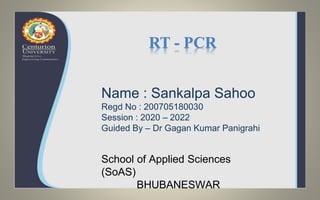
RT-PCR Guide
- 1. Name : Sankalpa Sahoo Regd No : 200705180030 Session : 2020 – 2022 Guided By – Dr Gagan Kumar Panigrahi School of Applied Sciences (SoAS) BHUBANESWAR RT - PCR
- 2. CONTENTS Introduction of RT-PCR PCR vs RT-PCR Basic principles Components used in RT-PCR Types of RT-PCR Applications References
- 3. INTRODUCTION OF RT-pCR RT-PCR stands for – Reverse Transcription Polymerase Chain Reaction It is one of many variants of the conventional PCR The discovery of reverse transciptase during the study of viral replicaton of genetic material led to the development of RT-PCR This technique is commonly used to detect RNA expression In this technique complimentary DNA (cDNA) transcripts are created from a given RNA to qualitatively detect gene expressions It is a combinaton of reverse trancription of RNA into DNA and amplification of specific Dna tragets using polymerase chain reaction
- 5. PCR vs RT-PCR Traditional PCR is used to exponentially amplify target DNA sequences RT-PCR is used to reverse transcribe mRNA to cDNA and then amplify it using traditional PCR In PCR, a double-stranded DNA molecule is used as the starting template In RT-PCR, a single-stranded RNA molecule is used as the starting template While PCR is less sensitive, RT-PCR is more sesitive Since mRNA is involved in translation, RT-PCR can give a measurement of gene expression that PCR can’t
- 7. Basic principles of rt-pcr RT-PCR involves total RNA isolation, reverse transcription (RT) and PCR. RNA is easily degraded since RNase is very hard to inactivate. So several precautions are taken. Total RNA isolation can be done by TRI reagent, Chloroform, isopropanol, 75% ethanol and molecular grade and RNase-free water. Reverse transcription is done by taking total RNA with reverse transcriptase, dNTP mixture, RNase inhibitor, Oligo dT primer and RNase-free water. PCR involves template cDNA from the RT, upstream and downstream primers, heat-stable DNA polymerase like Taq polymerase, dNTP mixture, agarose, ethidium bromide solution
- 8. components used in RT-pcr TRI reagent – It is a mixture of guanidine thiocyanate and phenol in a monophase solution. It dissolves DNA, RNA and protein. Reverse transcriptase (RTase) – They are used by certain viruses to replicate their genomes. We use M-MLV RTase and AMV RTase in RT-PCR. M-MLV – Moloney-murine leukemia virus AMV – Avian myeloblastosis virus dNTP – deoxynucleotide triphosphate. They are four types i.e. dATP, dCTP, dGTP, dTTP. Using dNTP provides single bases ready to go into DNA and double it.
- 9. RNase inhibitor (RI) – It is a leucine-rich repeat protein which forms extremely tight complexes with RNase. Murine is used for cDNA synthesis. Oligo dT primer – It is a single-stranded sequence of deoxythymine (dT) used for priming reactions catalysed by RTases. The transcript is primed in the poly(A) tail of mRNA. Taq polymerase – It is a heat-stable DNA polymerase I named after Thermus aquaticus. Agarose – It is a polysaccharide, generally extracted from some red seaweed. It is used to separate DNA by electrophoresis. Agarose gel have relatively large pore size. Ethidium bromide – It is commonly used as a fluorescent tag (nucleic acid stain) in agarose gel electrophoresis. When exposed to UV light, it will fluoresce with an orange colour.
- 10. This method is more sensitive than the one-step method. Primers in this case don’t need to be sequence specific.
- 11. One-step RT-PCR All reaction components are mixed in one tube and the reaction is carried out. It offers simplicity and convenience. It also minimizes the chances of contamination. The primers must be sequence specific. The resulting cDNA can’t be used to detect multiple informations from a single RNA sample.
- 12. applications RT-PCR is a relatively simple, inexpensive, extremely sensitive and specific way to determine the expression level of target genes. It is widely used in biomedical science research to detect genetic diseases and semi-quantitatively to determine the abundance of different RNA molecules within a cell. In this method a very low copy number of RNA molecules can be detected. It is also used in research methods like expression of Gal genes in yeast cells.
- 13. Gene insertion – It is also very useful in insertion of eukaryotic genes into prokaryotes. It is used to study genetic materials of retroviruses like HIV and other RNA containing viruses like Influenzavirus A. Cancer detection – This use of RT-PCR is under serious study and research. Scientists are studying how to effectively use this method in detecting cancers. Genetic disease diagnosis – It can be used to detect diseases like Bird flu- H7N9, Lesch-Nyhan syndrome, COVID-19, Ebola etc.
- 14. REFERENCES Reverse transcription polymerase chain reaction (https://en.wikipedia.org/wiki/Reverse_transcription_polymeras e_chain_reaction) Introduction of RT-PCR (http://www.slideshare.net/Shababmehebub/introduction-of-rt- pcr-69566089) RT-PCR : One-step vs Two-step (https://www.thermofisher.com/in/en/home/brands/invitrogen/m olecular-biology-technologies/spotlight-articles/onestep-vs- twostep-rtpcr.html) Application of RT-PCR and real-time PCR (https://www.ncbi.nlm.nih.gov/pmc/articles/PMC5087796)